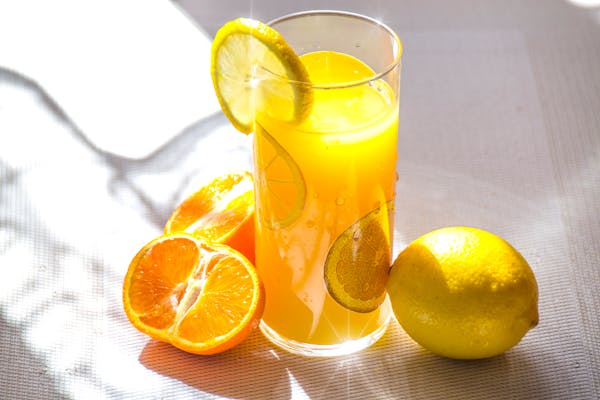The Invisible Ruler
How Scientists Set the Standard for Preservative Testing in Your Orange Juice
Article Navigation
Introduction: The Preservative Puzzle
Picture this: you're enjoying a glass of tangy orange juice, unaware that it contains a silent guardian—benzoic acid. This common preservative fights microbial growth but poses health risks if超标. In the EU, orange juice can contain ≤300 mg/kg of benzoic acid; in the US, it's ≤1,000 mg/kg. How do labs worldwide ensure their measurements of this additive are accurate? Enter proficiency testing (PT), the unsung hero of food safety. At its core lies a deceptively simple question: What is the "true" value of benzoic acid in this juice? This article unveils the high-stakes science of assigning traceable reference values in PT programs—a process combining metrology, statistics, and analytical chemistry to safeguard your breakfast. 2 5

The Proficiency Testing Playbook
What is PT and Why Does It Matter?
Proficiency testing is a laboratory "stress test." Labs receive identical samples (like orange juice spiked with benzoic acid) and must report their measurements. Their results are compared against an assigned value—a reference concentration established with ultra-high precision. The Government Laboratory of Hong Kong, an ISO/IEC 17043:2010-accredited PT provider, runs schemes like GLHK PT 24-03 (benzoic acid in soybean sauce) to evaluate lab performance. Without PT, inconsistent results could jeopardize public health—imagine juice with double the legal preservative limit slipping into supermarkets! 2
The Traceability Imperative
Traceability means linking measurements to unbroken chains of references, typically Certified Reference Materials (CRMs) or primary methods. For benzoic acid, this might involve:
- CRM Purchase: A benzoic acid CRM (e.g., NIST SRM 2389) with purity certified at 99.8% ± 0.1%.
- Sample Fortification: Adding precise masses of CRM to preservative-free orange juice.
- Homogenization: Ensuring even distribution via high-shear mixing.
Anatomy of a PT Assigned Value: The Orange Juice Experiment
Step-by-Step: Crafting the Reference
In a fictional but protocol-accurate PT scheme, scientists determine the assigned value for benzoic acid in orange juice:
Sample Preparation
- Base Matrix: Fresh oranges processed via ultrasound and high-pressure treatment to mimic "fresh-like" juice without preservatives.
- Fortification: Spiking juice with benzoic acid CRM at 200 mg/kg (mid-regulatory range).
- Homogenization: High-pressure processing (600 MPa for 3 min) ensures uniformity.
Value Assignment
- Method 1: LC-MS/MS Triple Play
- Extraction: Juice mixed with methanol, centrifuged, filtered.
- Analysis: LC-MS/MS with deuterated benzoic acid as internal standard.
- Method 2: GC-FID Cross-Verification
- Method 3: Potentiometric Titration
Results: The Data Speaks
| Method | Mean Value (mg/kg) | Uncertainty (mg/kg) | Traceability Anchor |
|---|---|---|---|
| LC-MS/MS | 198.7 | ±2.1 | NIST SRM 2389 CRM |
| GC-FID | 200.3 | ±3.5 | In-house primary standard |
| Potentiometry | 196.9 | ±4.8 | EURAMET certified reference |
| Assigned Value | 198.6 | ±1.9 | Combined uncertainty (k=2) |
The assigned value (198.6 mg/kg) integrates all methods, weighted by uncertainty. Labs reporting 196.7–200.5 mg/kg pass.
| Statistical Metric | Value | Acceptability Threshold |
|---|---|---|
| Assigned Value | 198.6 mg/kg | Fixed |
| Robust SD | 8.2 mg/kg | - |
| Z-Score Range (Pass) | -1.8 to +1.9 | |Z| ≤ 2.0 |
| Failure Rate | 6.7% | Action if >10% |
The Scientist's Toolkit: Essential Reagents and Instruments
| Item | Function | Critical Feature |
|---|---|---|
| Benzoic Acid CRM | Calibration anchor | Purity ± 0.1% (e.g., NIST SRM 2389) |
| Deuterated Internal Std | Corrects matrix effects in LC-MS/MS | D₅-benzoic acid, 99.9 atom % D |
| C18 SPE Cartridges | Pre-concentrates benzoic acid | >99% recovery in citrus matrices |
| Mobile Phase Buffers | Ensures peak separation in chromatography | pH 2.5 ammonium formate/acetonitrile |
| Stability Preservatives | Prevents microbial degradation during PT | 0.1% sodium azide in sample vials |
Beyond the Numbers: Implications for Consumers and Labs
The Ripple Effect of Traceability
- For Labs: A 2024 PT round (GLHK PT 24-03) showed labs using CRMs cut measurement uncertainty by 37% versus in-house standards.
- For Industry: Juice brands using PT-validated labs can market products with "ISO 17025-compliant preservative monitoring"—a trust signal.
- For Regulators: Disputes over border-rejected shipments are resolved via PT-aligned methods.
Emerging Frontiers
New techniques are boosting precision:
- Molecularly Imprinted Polymers (MIPs): Extract benzoic acid from citrus oils with 98% specificity.
- High-Resolution PT Schemes: Like DRRR's mineral oil in edible oils (2025), now adapting to preservatives. 5
Conclusion: The Silent Guardian in Your Glass
Proficiency testing transforms abstract regulations into actionable science. By anchoring assigned values to metrological bedrock—CRMs, primary methods, and consensus statistics—PT programs ensure that a milligram of benzoic acid in Shanghai equals a milligram in Paris. For consumers, this means every sip of orange juice is guarded by an invisible ruler: one meticulously calibrated, globally harmonized, and tirelessly validated.
Final Thought: As one PT coordinator quipped, "We don't just test samples; we test trust."